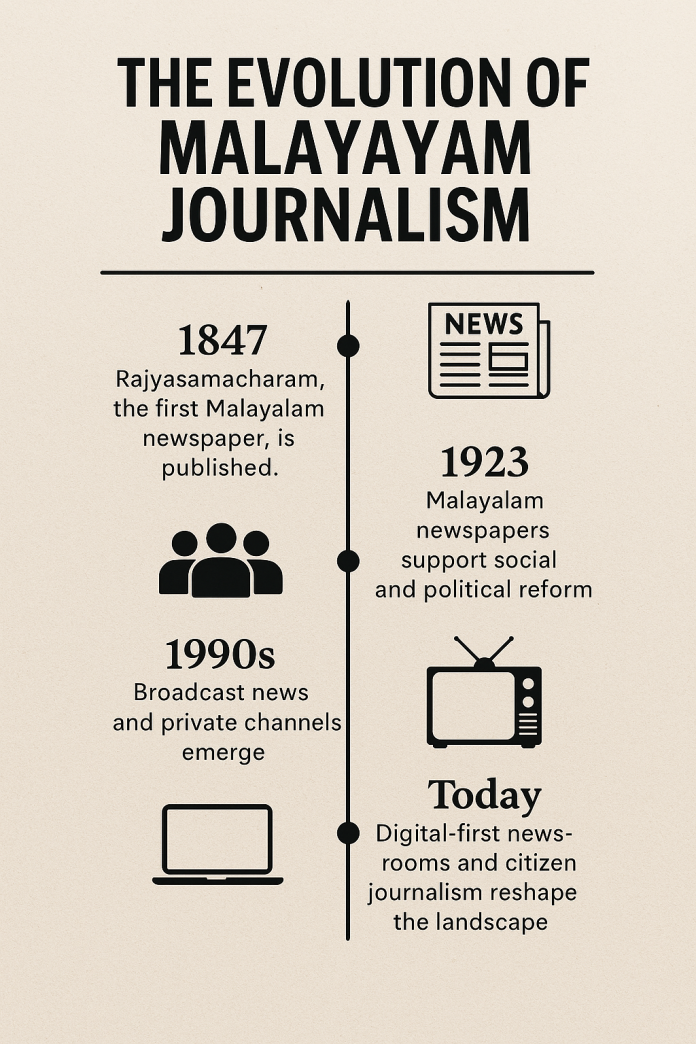🧭 The Evolution of Malayalam Journalism
From Ink to Internet: Tracing Kerala’s Legacy of Press Freedom and Public Discourse
Journalism in Kerala is not just a profession. it is a tradition rooted in reform, resistance, and relentless pursuit of truth. The state has long stood at the forefront of India’s media movement, thanks to a literate society, progressive politics, and socially conscious readership. Let us journey through the landmark moments that shaped Malayalam journalism from its humble beginnings to its powerful digital presence today.
📰 The Birth of Malayalam Journalism
The story begins in 1847, when Rev. Hermann Gundert, a German missionary, published Rajyasamacharam, the first Malayalam newspaper, from Thalassery. Though primarily religious in nature, it marked a turning point in regional communication. Shortly after, Paschimodayam followed, addressing more secular issues and broadening the readership.
📚 Journalism and the Reform Movement
By the late 19th and early 20th centuries, Malayalam journalism evolved into a powerful medium of social and political reform. Newspapers like Malayala Manorama (established 1888), Mathrubhumi (1923), and Deshabhimani (1942) became influential voices during the freedom struggle and the temple entry movement. These publications not only disseminated news but also challenged caste hierarchies and promoted equality.
🗞️ Post-Independence Expansion
The post-1947 era saw Malayalam journalism flourish with the rise of regional media houses and increased literacy. The 1960s and 1970s witnessed the professionalization of journalism, the emergence of television, and the institutional training of media professionals. Malayalam daily circulation rose steadily, outpacing many other states due to Kerala’s deep reading culture.
📺 The Age of Broadcast and Private Channels
In the 1990s, Kerala entered the broadcast era, with Doordarshan’s regional bulletins paving the way for private Malayalam news channels like Asianet News, Manorama News, and Reporter TV. These outlets played a crucial role in bringing current affairs to living rooms, transforming journalism into a visual, real-time experience.
🌐 Digital Revolution and Citizen Media
Today, Kerala is experiencing a digital shift, with online portals, YouTube channels, podcasts, and citizen journalism reshaping how news is produced and consumed. Independent journalists, grassroots reporters, and bloggers are gaining visibility alongside traditional giants. Social media has amplified marginalized voices while raising concerns about misinformation and journalistic ethics.
👤 Prominent Figures Who Shaped Malayalam Media
-
K. P. Kesava Menon – Founder of Mathrubhumi, nationalist, and visionary journalist.
-
M. Sukumaran – A literary journalist who bridged fiction and reportage.
-
K. M. Roy – Known for his fearless investigative journalism.
-
M. V. Devan – Prominent critic and editor who influenced art and literature journalism.
📌 Challenges Ahead
While technology has democratized news, it has also blurred lines between journalism and sensationalism. The pressure to gain views often competes with the need for factual reporting. The role of journalism as a pillar of democracy must be upheld through responsible practices, training, and institutional support something the Bharat Media Association (BMA) actively promotes.
✅ Conclusion
From the printing press to the smartphone screen, Malayalam journalism has journeyed through centuries with its core values of truth, justice, and public service intact. Its resilience is a testament to Kerala’s unwavering commitment to free speech and informed citizenship. As we move forward, let us honor this legacy by supporting ethical, inclusive, and empowered journalism.









